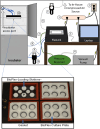The effect of the mechanodynamic lung environment on fibroblast phenotype via the Flexcell
- PMID: 39068387
- PMCID: PMC11282647
- DOI: 10.1186/s12890-024-03167-7
The effect of the mechanodynamic lung environment on fibroblast phenotype via the Flexcell
Abstract
The lung is a highly mechanical organ as it is exposed to approximately 109 strain cycles, (where strain is the length change of tissue structure per unit initial length), with an approximately 4% amplitude change during quiet tidal breathing or 107 strain cycles at a 25% amplitude during heavy exercises, sighs, and deep inspirations. These mechanical indices have been reported to become aberrant in lung diseases such as acute respiratory distress syndrome (ARDS), pulmonary hypertension, bronchopulmonary dysplasia (BPD), idiopathic pulmonary fibrosis (IPF), and asthma. Through recent innovations, various in vitro systems/bioreactors used to mimic the lung's mechanical strain have been developed. Among these, the Flexcell tension system which is composed of bioreactors that utilize a variety of programs in vitro to apply static and cyclic strain on different cell-types established as 2D monolayer cultures or cell-embedded 3D hydrogel models, has enabled the assessment of the response of different cells such as fibroblasts to the lung's mechanical strain in health and disease. Fibroblasts are the main effector cells responsible for the production of extracellular matrix (ECM) proteins to repair and maintain tissue homeostasis and are implicated in the excessive deposition of matrix proteins that leads to lung fibrosis. In this review, we summarise, studies that have used the Flexcell tension bioreactor to assess effects of the mechanical lung on the structure, function, and phenotype of lung fibroblasts in homeostatic conditions and abnormal environments associated with lung injury and disease. We show that these studies have revealed that different strain conditions regulate fibroblast proliferation, ECM protein production, and inflammation in normal repair and the diseased lung.
Keywords: Cyclic and static strain; Flexcell tension bioreactor; Frequency; In vitro models; Lung fibroblasts; Mechanical lung environment; Strain amplitudes.
© 2024. The Author(s).
Conflict of interest statement
The authors declare no competing interests.
Figures



References
-
- Mead J, Loring SH. Analysis of volume displacement and length changes of the diaphragm during breathing. J Appl Physiol Respir Environ Exerc Physiol. 1982;53(3):750–5. - PubMed
-
- Haddad M, Sharma S. Physiology, Lung. StatPearls, Treasure Island (FL): StatPearls Publishing; 2023.
-
- Powers KA, Dhamoon AS. Physiology, Pulmonary Ventilation and Perfusion. StatPearls, Treasure Island (FL): StatPearls Publishing; 2023. - PubMed
-
- Cardozo CP. Mechanotransduction: Overview," Encyclopedia of Bone Biology. Elsevier; 2020. p. 217.
Publication types
MeSH terms
Grants and funding
- AWD-024378/Natural Sciences and Engineering Research Council of Canada
- AWD-024378/Natural Sciences and Engineering Research Council of Canada
- AWD-024378/Natural Sciences and Engineering Research Council of Canada
- AWD-024378/Natural Sciences and Engineering Research Council of Canada
- AWD-024378/Natural Sciences and Engineering Research Council of Canada
- AWD-024378/Natural Sciences and Engineering Research Council of Canada
- 42539/Canada Foundation for Innovation
LinkOut - more resources
Full Text Sources

